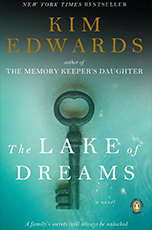 Nearly a century after the Titanic sank on its ill-fated maiden journey in 1912, a new theory about the cause of the iceberg collision has been brought forth. Novelist Louise Patten, granddaughter of Charles Lightoller, who served as the Titanic’s Second Officer, blames an error committed by the steersman. In an interview with The Independent, Patten explains that sailing ships and steam ships used different steering systems during that era. Each system was the complete opposite of the other. “So a command to turn ‘hard a-starboard’ meant turn the wheel right under one system and left under the other…The steersman panicked and the real reason why Titanic hit the iceberg, which has never come to light before, is because he turned the wheel the wrong way.” In another interview published by Reuters, Patten also blames J. Bruce Ismay, chairman of White Star Line, the company that owned the Titanic, for pushing the captain to continue sailing, causing the ship to sink hours faster than if it had stood still. Read more…
Nearly a century after the Titanic sank on its ill-fated maiden journey in 1912, a new theory about the cause of the iceberg collision has been brought forth. Novelist Louise Patten, granddaughter of Charles Lightoller, who served as the Titanic’s Second Officer, blames an error committed by the steersman. In an interview with The Independent, Patten explains that sailing ships and steam ships used different steering systems during that era. Each system was the complete opposite of the other. “So a command to turn ‘hard a-starboard’ meant turn the wheel right under one system and left under the other…The steersman panicked and the real reason why Titanic hit the iceberg, which has never come to light before, is because he turned the wheel the wrong way.” In another interview published by Reuters, Patten also blames J. Bruce Ismay, chairman of White Star Line, the company that owned the Titanic, for pushing the captain to continue sailing, causing the ship to sink hours faster than if it had stood still. Read more…

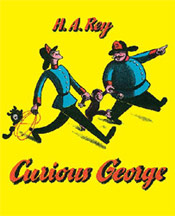
First edition cover, 1941
In a column posted on the American Libraries Magazine website earlier this month, Jennifer Burek Pierce argues that children’s books, like the ever popular Curious George series, should garner more literary merit. “To represent the world for children involves skillful choices based on training, research, and lived experience.” Often times the simple words and captivating imagery of a 32-page picture book impart important life lessons or cultural themes. Such is the case with Curious George, the creation of husband and wife Margret and H. A. Rey. As German Jews, the couple was forced to flee France in 1940 as the Nazi army rolled toward Paris. They escaped on bicycles, and carried among their few belongings several manuscripts of children’s books, one of which featured a mischievous monkey named Fifi. Read more…

Categories: Children's Book, Classic, Fiction, News Tags: Allan Drummond, Curious George, Curious George Saves the Day, H. A. Rey, history, Louise Borden, Margret Rey, The Journey That Saved Curious George, World War II
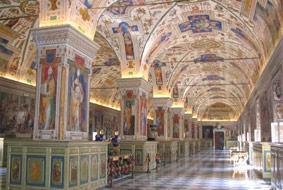
The Sistine Hall in the Vatican Library.
After three yeas of extensive remodeling, the Vatican Library will finally re-open its doors to researchers and scholars on September 20, 2010. According to the Rome Reports website, the majority of the remodel was focused on upgrading library security, and now all books will be tracked electronically using RFID tags. “Each book is identified by a computer code, a tag with an electronic chip. Then, according to the user, there may be places accessible or forbidden depending on the volume and the person who takes the book,” explains Msgr. Cesare Pasini, Director of the Vatican Library. Now the location of every book will be known at all times, and any unauthorized removal of a book from a restricted area, or even the library premises, can be prevented. RFid Gazette has identified the electronic tags used in the library as Texas Instruments’ Tag-it™ models. Additionally, cameras and security arches have also been installed in each room.
Read more…

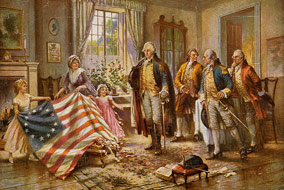
"The Birth of Old Glory" by Percy Moran
In the spirit of patriotism surrounding the 4th of July, history professor Marla Miller has written a new book about Betsy Ross, the iconic patriot best known for sewing the first American flag. In Betsy Ross and the Making of America (Henry Holt, 467pgs) Miller investigates the story of Ross and her most famous creation, drawing some very interesting conclusions. Working as an upholsterer, Ross’ skill and quality of craftsmanship was well known, and it is documented that she made numerous flags, pennants and standards for the government during the Revolutionary War. But, there is no written historical record proving the seamstress made America’s first flag by herself. “Miller reminds us, the flag, ‘like the Revolution it represents, was the work of many hands,’” writes Marjoleine Kars in a review for The Washington Post.
Read more…

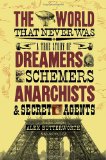 By Alex Butterworth
By Alex Butterworth
Pantheon | 528pgs
Release Date: June 15, 2010
Summary:
Historian Alex Butterworth studies the years spanning the late 19th and early 20th centuries when unstable global economies and social upheavals turned some young people into anarchist terrorists, in The World That Never Was: A True Story of Dreamers, Schemers, Anarchists, and Secret Agents. The intense, captivating narrative follows the anarchist movement from its beginnings in a struggling Paris Commune in 1871, to the bloody Russian Revolution in 1905, and finally to the movement’s decline in the 1930′s. The story line moves between, Europe, Russia and the U.S. and prominent anarchist leaders such as Kropotkin, Rochefort, and Bakunin, are discussed. As the disenchanted social idealists resort to increasingly violent acts of terrorism in pursuit of a utopian way of life, governments react by creating secret police forces to investigate and prosecute the anarchists. Drawing parallels with today’s turbulent political landscape, Butterworth offers this history as a cautionary tale in hopes that new generations will not repeat the bloody mistakes of the past.
Read more…

Categories: New Release, Non-Fiction Tags: Alex Butterworth, anarchist, anarchy, Bakunin, history, Kropotkin, Pompeii: The Living City, Rochefort, terrorism, The World That Never Was
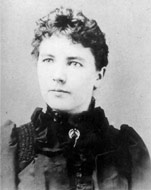
Laura Ingalls Wilder
A couple of years ago, author Wendy McClure made an impromptu revisit of a childhood favorite: the Little House series of books written by Laura Ingalls Wilder. In an interview with Knee-Jerk, McClure discusses her re-discovery of the classic childrens’ series and the work that they inspired. “…I was always kind of afraid to go back and reread them, because I feared that they wouldn’t be as good as I remembered,” she explains. “I think I wanted to re-immerse myself and see where it went…I was reading the books and loving them and started telling everyone I knew, ‘It’d be fun to see these places and write a book about it sometime’.” Supportive prodding from a friend in the publishing industry prompted McClure to write The Wilder Life (set to be released in early 2011), a travelogue of sorts, about the author’s experiences visiting historical sites related to the books. “I liked the idea of seeing all these places I felt I knew so well but had never actually been to.”
Read more…

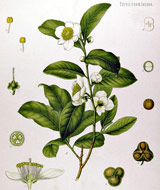
Camellia sinensis
The British Empire enjoyed incredible power and influence during the 19th century, and though its control extended around the globe, it was the lack of control of a small plant that caused a serious issue. The plant in question, Camellia sinensis, used to make tea, was in serious demand by 1800 as the “cuppa” became a British institution. The problem was that China controlled the world’s tea production, and was no longer interested in trading opium for tea as they had in the past. Beginning in 1850, British entrepreneurs sought to develop tea growing in India, the Asian country under the empire’s control, and employed Scotsman Robert Fortune to steal China’s tea making secrets. Sarah Rose writes about this industrial intrigue in the new book For All the Tea In China: How England Stole the World’s Favorite Drink and Changed History (Viking Adult, 272pgs). The author calls this endeavor to wrest control of the tea trade the “greatest single act of corporate espionage in history.”
Read more…

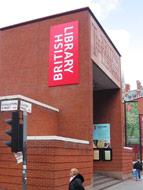 The Klencke Atlas, a magnificent 350 year-old tome that boasts the title of the world’s largest book, will go on public display with its pages open for the first time, at the British Library. The book was given to King Charles II in 1660 by Dutch merchants, to commemorate his restoration to the British throne. It is approximately 6 ft. tall by 3 ft. wide, when closed, and contains 37 maps detailing the most comprehensive geographic and historical information of that era. The maps, printed from exquisitely engraved copper plates, were initially intended to be removed from the book and displayed on walls, hence the enormous size. Charles II kept the book intact, storing it in his cabinet of curiosities. King George III gave it to the British Museum 1828, as part of a large gift of geographic and topographic materials. It has since remained at the institution, out of public view.
The Klencke Atlas, a magnificent 350 year-old tome that boasts the title of the world’s largest book, will go on public display with its pages open for the first time, at the British Library. The book was given to King Charles II in 1660 by Dutch merchants, to commemorate his restoration to the British throne. It is approximately 6 ft. tall by 3 ft. wide, when closed, and contains 37 maps detailing the most comprehensive geographic and historical information of that era. The maps, printed from exquisitely engraved copper plates, were initially intended to be removed from the book and displayed on walls, hence the enormous size. Charles II kept the book intact, storing it in his cabinet of curiosities. King George III gave it to the British Museum 1828, as part of a large gift of geographic and topographic materials. It has since remained at the institution, out of public view.
Read more…

 By Edward Rutherfurd
By Edward Rutherfurd
Doubleday | 880pgs
Release Date: November 10, 2009
Bestselling historical novelist, Edward Rutherfurd, weaves the compelling strands of The Big Apple’s rich history into a fascinating multi-generational tale. The story follows several families, from different ethnic and economic backgrounds, through the years as their fates intertwine to become part of the tapestry of New York’s history. New York: The Novel spans more than three centuries, beginning in the 1600′s with the Native American and Dutch settlements, leading into the bloody conflicts of the Revolutionary and Civil wars, followed by the explosion of the Industrial revolution and the tragedy of the Triangle Shirtwaist Fire. Rutherfurd details New York’s development as a financial center, and its rapid population growth due to massive waves of immigrants looking for a better life in the late 1800′s and early 1900′s. Readers experience New York’s rocky ride in the 20th century, with the stress of World War II and the financial recession of the ’70′s, as well as its economic and cultural resurgence in the ’90′s. The tragic events of 9/11 and the collapse of the World Trade Center bring the novel to a close.
Read more…

 Nearly a century after the Titanic sank on its ill-fated maiden journey in 1912, a new theory about the cause of the iceberg collision has been brought forth. Novelist Louise Patten, granddaughter of Charles Lightoller, who served as the Titanic’s Second Officer, blames an error committed by the steersman. In an interview with The Independent, Patten explains that sailing ships and steam ships used different steering systems during that era. Each system was the complete opposite of the other. “So a command to turn ‘hard a-starboard’ meant turn the wheel right under one system and left under the other…The steersman panicked and the real reason why Titanic hit the iceberg, which has never come to light before, is because he turned the wheel the wrong way.” In another interview published by Reuters, Patten also blames J. Bruce Ismay, chairman of White Star Line, the company that owned the Titanic, for pushing the captain to continue sailing, causing the ship to sink hours faster than if it had stood still. Read more…
Nearly a century after the Titanic sank on its ill-fated maiden journey in 1912, a new theory about the cause of the iceberg collision has been brought forth. Novelist Louise Patten, granddaughter of Charles Lightoller, who served as the Titanic’s Second Officer, blames an error committed by the steersman. In an interview with The Independent, Patten explains that sailing ships and steam ships used different steering systems during that era. Each system was the complete opposite of the other. “So a command to turn ‘hard a-starboard’ meant turn the wheel right under one system and left under the other…The steersman panicked and the real reason why Titanic hit the iceberg, which has never come to light before, is because he turned the wheel the wrong way.” In another interview published by Reuters, Patten also blames J. Bruce Ismay, chairman of White Star Line, the company that owned the Titanic, for pushing the captain to continue sailing, causing the ship to sink hours faster than if it had stood still. Read more…








